How and how to feed roses during flowering?
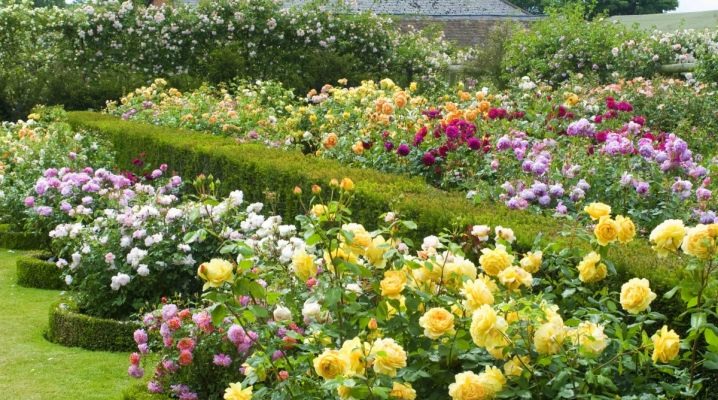
Rose is a demanding culture. The most beautiful and lush varieties require enhanced nutrition. Let's see what and how to feed roses during flowering.

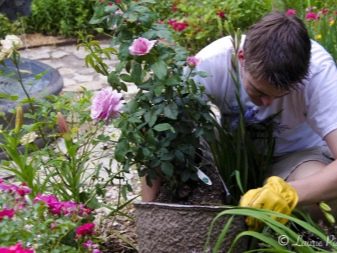
The need for a procedure
Like any lush flowering plant, the rose absorbs large amounts of nutrients from the soil. Fertilizing it is useful, even if the plant was originally planted in rich soil. In summer, the rose requires important nutrients.
- Phosphorus. It is especially useful during the budding period, is responsible for the size and abundance of buds, strong stems, stimulates the formation of roots.
- Potassium. Actively required during the period of bud formation. Affects their quantity and quality of petals. It has a positive effect on the absorption of other substances.
- Magnesium. Affects the intensity of the color.
- Iron. Important for photosynthesis, prevents chlorosis.
- Calcium. It is necessary for the growth of shoots, the formation of buds.
The rule is strictly observed: nitrogen - at the beginning of the growing season, potassium, calcium and phosphorus - during flowering and fruiting. Chicken manure, manure and other organic matter with a high nitrogen content are not used during flowering or late summer. Such dressings provoke the growth of wood, green shoots. The plant will not have time to prepare for winter.
Actively blooming roses are also not worth feeding, it is necessary to choose the moments when the plant is not at its peak.

Fertilization methods
Top dressing is applied in two ways.
- Root. The fertilizer solution is applied to the soil. The roses need to be watered first.
- Foliar. Leaves are sprayed from a spray bottle. Pros: Simultaneous humidification in dry summers.
Fertilizers can be applied under the roots not in liquid form, but in dry form. The dry fertilizer is distributed over the already watered soil, slightly loosened and immediately mulched, or the fertilizer is placed in the grooves. Dig holes or grooves around the bush, lay dry fertilizer in them, sprinkle them with earth. The fertilizer is gradually washed out into the soil during rains or watering.
Foliar dressing is effective if you need to quickly feed the plant.

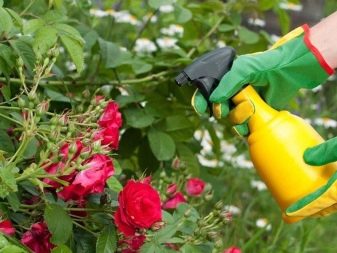
What is being used?
Gardeners are constantly looking for the best nutrition. In fact, the best one will be the one that works well in the specific conditions. The effectiveness of top dressing depends on the variety, the initial qualities of the soil and the conditions on the site. Folk dressings can be effective if applied correctly.
Consider how to feed roses during flowering on special occasions.
- Sour soil on the site, the likelihood of a rose being damaged by root rot is ash or ash infusion. 1-1.5 glasses of ash are scattered under the bush. Preparation of the infusion: 1/3 of the ash bucket is poured to the brim with hot water, insisted for 2 days, filtered. 1 liter is poured onto 1 bush.
- The climbing rose is fed in the summer, like any other. These roses differ from others only in the spring, when they need more nitrogen - to build up a large green mass after wintering.
- For older shrubs, baking soda will work. It is a source of calcium. Rejuvenates, provides lush bloom. Take 1 tsp for 5 liters of water. soda, add magnesium sulfate (1 tsp) and 0.5 tsp. ammonia. The resulting solution is carefully sprayed with roses in the garden.
- If there is poor soil on the site, it is useful to water young plants every 3 weeks with liquid fertilizers for tomatoes. Such feeding will strengthen the bushes, in the next years you can switch to lighter feeding.
For adults, actively flowering plants in an already well-cultivated area on the street, organic matter is ideal: manure or droppings before flowering.

Chicken droppings
The following recipe is most often used: for 1 part of the litter - 20 parts of water, insist under the lid for 2 weeks. Mix the concentrate well. Dilute 10 times. For 1 sq. m you need 10 liters of a diluted solution. Chicken droppings are watered before buds form and immediately after the first wave has faded.

Kitchen waste
Consider the most popular recipes for such dressings.
- Banana peel powder. They are cut into small pieces, dried, ground into powder in a blender. 1 tbsp is applied under the bush. l. It is a mild source of potassium, magnesium, iron, and calcium. Can be applied at any time of summer if desired.
- Infusion on banana skins. Skins with 5-7 bananas are placed in a 3 liter jar, poured with warm water, insisted for 3 days. The resulting solution is watered or sprayed with bushes.
- Infusion of nettle leaves. A bucket is filled 2/3 with chopped nettles, filled with water so that it just covers the greens. Withstand 10 days under the lid, stir occasionally. Dilute and dilute 10 times with clean water. A valuable source of potassium and iron.
- Eggshell. You can apply it as a powder directly to the soil or prepare an infusion. The shell of 5 eggs is poured with 5 liters of water. They insist for three days. The resulting liquid is poured over the bushes, 1 liter per bush.
Ordinary tea leaves are also suitable - they are scattered under the bush, tomato tops as a remedy for pests and coffee grounds, which are an excellent source of potassium.
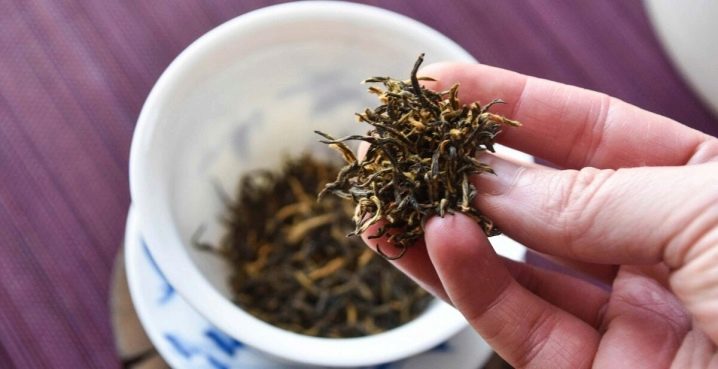
Yeast
Yeast is a natural biostimulant. However, they slightly acidify the soil, wash out calcium and potassium from the soil, require careful selection of the timing of feeding and are dangerous if they get on the leaves. The composition of the yeast is complex, but a significant part, 16%, is nitrogen. Therefore, it is better to feed the plants with nitrogen during the period of shoot formation, but not buds. Fertilizer is well suited for roses that require an abundant number of flowers, and their size is not important.
Recipe: pour 10 g of dry yeast into a bucket of warm water (10 l), add 2 tbsp. l. Sahara. Wait for fermentation and dilute with clean water 5 times. 1 bush needs 1 liter of fresh solution.

Cow dung
The basic recipes that summer residents often use are considered the most effective.
- 1 part of fresh manure is poured with 5 parts of water. Cover with a lid with holes, incubate for 7 days. Stir occasionally. After a week, filter, dilute with clean water 3 times. For 1 sq. m you need 3 liters of ready-made solution.
- 1 part of rotted manure is poured with 3 parts of water. Then they act as in the previous recipe.
Terms of application: before flowering, at the beginning of summer, as well as in the intervals between flowering waves.
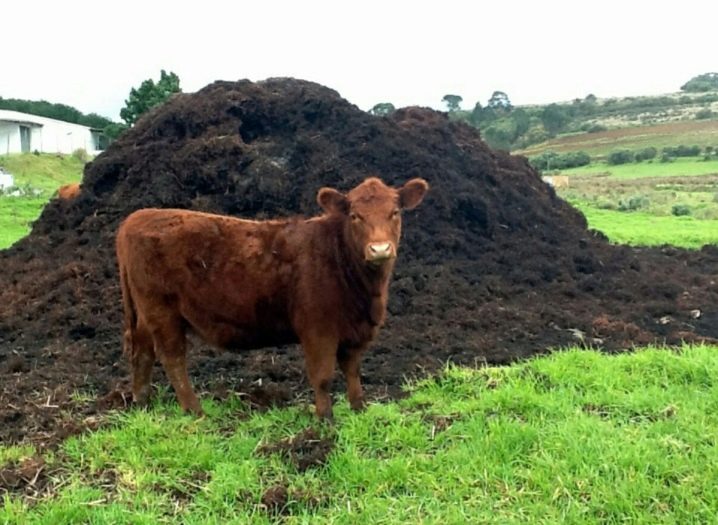
Ammonia
Ammonia, or ammonia, is used as spring feeding. But for weak or young roses, it can be used during the summer, up to 3 times. It is a nitrogen source that protects roses from pests and diseases at the same time. It is used for healthy, shiny foliage. A 10 liter bucket needs 30 ml of ammonia.
For watering, use 1 liter of solution per bush.
For spraying against pests and simultaneous feeding, mixtures are suitable (dosages per 10 liters or a bucket of water):
- 50 ml of ammonia, 1 tbsp. l. wood ash;
- 60 ml of ammonia, a quarter of a bar of laundry soap (rub the soap on a grater so that it dissolves faster).
For more effective treatment from aphids, apple cider vinegar or salicylic acid 2% (0.5 tsp each) is added to the solution.
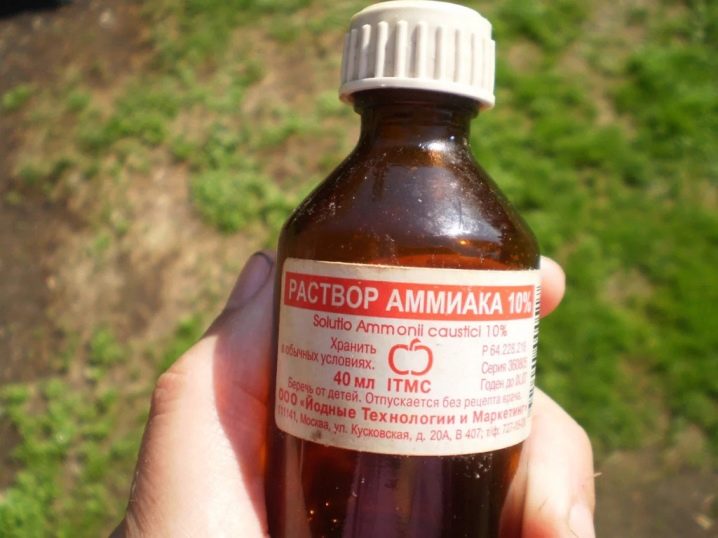
Ready complex fertilizers
Nitroammofoska is better suited for fertilization not in summer, but in spring. It is the optimal fertilizer for already mature roses during the period of shoot growth. You can take monopotassium phosphate - it contains only potassium and phosphorus salts, it is well absorbed. Very good during budding. Better yet, versatile mixes. They are produced by many firms, the most popular means: Agricola, Kemira Lux, Azotovit, Kristalon, AgroPrirost, Compo, Green Belt, Fertika, Bona Forte, Buyskie fertilizers for roses ”, ASB Greenworld. Many of them contain not only macronutrients, but also vitamins, succinic acid, humic substances.
They are used strictly according to the instructions.
Mineral mixtures can be composed independently.
- For early feeding: ammonium nitrate - 15 g, superphosphate - 30 g, potassium sulfate - 10 g. Mix the powder, distribute over an area of 1 sq. M. m or dissolve in 10 liters of water, pour over 1 sq. m.
- For feeding after the first wave of flowering: superphosphate - 40 g, potassium salt - 15 g for the same amount of water and footage.
- For feeding in August: superphosphate - 30 g, potassium magnesium - 30 g, potassium salt - 15 g.
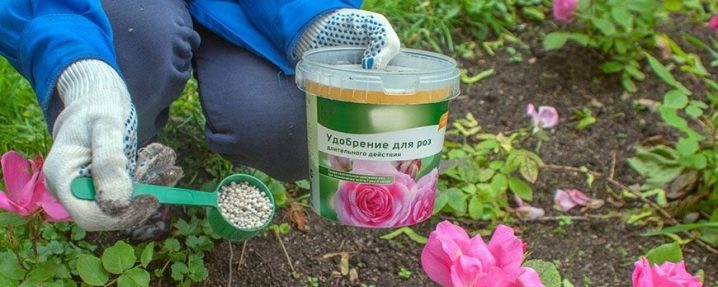
Means for foliar feeding
There are different options for foliar dressing.
- Infusion of mullein. Insist 1 week 1 part of fresh manure in 5 parts of water. Filter, dilute 5 times.
- Ash infusion. Pour 300 g of ash with boiling water, boil for half an hour, cool, strain, dilute in 10 liters of water, add 50 g of laundry soap.
- Alfalfa tea. Alfalfa is sold at pet stores. For 10 liters of water, you will need 1 glass of alfalfa pellets. Insist under the lid for a week. Dilute 2 times with clean water before spraying. Great for stimulating re-flowering.
Ready-made mineral mixtures are well suited for foliar dressing.
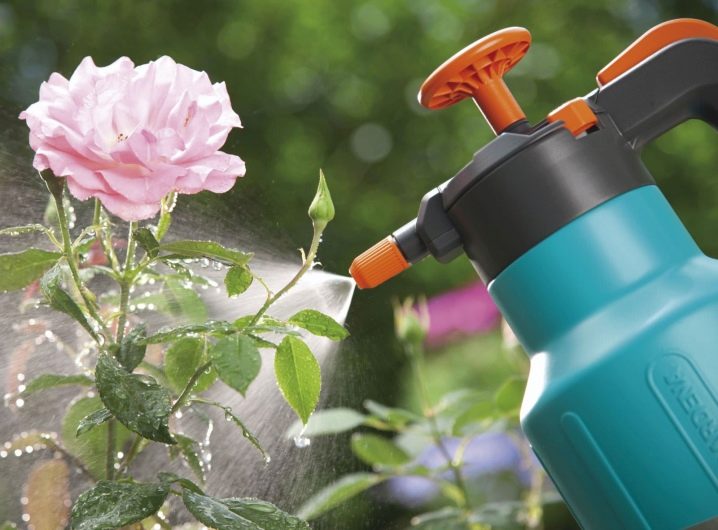
Fundamental rules
The best time for the first feeding is when the roses have picked up buds. The second feeding - as soon as the first wave fades and the rose begins to gain strength before the next. During the second flowering, you can make a soft potassium-phosphorus dressing.
It is better not to feed directly during the flowering period - this does not interfere with the plant, but the flowering may not be so long and lush, since the rose begins to spend energy on the supply, and not the return. Top dressing at the very peak of flowering will be appropriate in case of nutritional deficiency. Continuously blooming roses are fed, choosing the moments when the flowering becomes weaker.

Approximate feeding times:
- in the beginning - mid-June (the rose buds are just beginning to form);
- at the end of June - July - 2 weak dressings after an interval of at least 10 days;
- in August, after flowering.
Sometimes they recommend 5 dressings per season, sometimes no more than 2. When drawing up a dressing schedule, they are guided by the characteristics of their plant and the available dressing options. Basic rule: feed before and after flowering, as well as between waves. If the summer is rainy or during the first feeding mistakes were made, then they are also fed directly during the flowering period.
If the solution for dressing is weak (a glass of an already diluted mullein in a bucket of water), then you can water it once a week, the number of dressings will increase to 10 over the summer.

It is worth considering common mistakes.
- Overfeeding, especially nitrogen. Although there is an opinion that it is difficult to overfeed roses.
- Top dressing during active flowering.
- Watering with liquid fertilizer on dry soil, root burns.
- Fertilizer is applied too often, more often once every 2 weeks.
- Fertilizers are not balanced (excess calcium leads to a deficiency, since the plant cannot absorb it).
It is important to keep track of agricultural technology. Well-groomed plants tolerate flaws in dressing calmly. In caring for sick plants weakened by drought or dampness, it is better to focus on growth stimulants: "Epin", "Zircon", "Floral lignohumate", "Plant life activator HB-101".
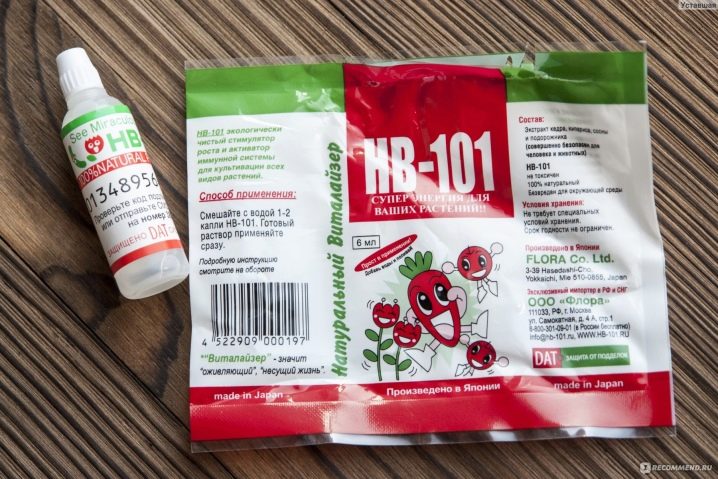

































































































The comment was sent successfully.